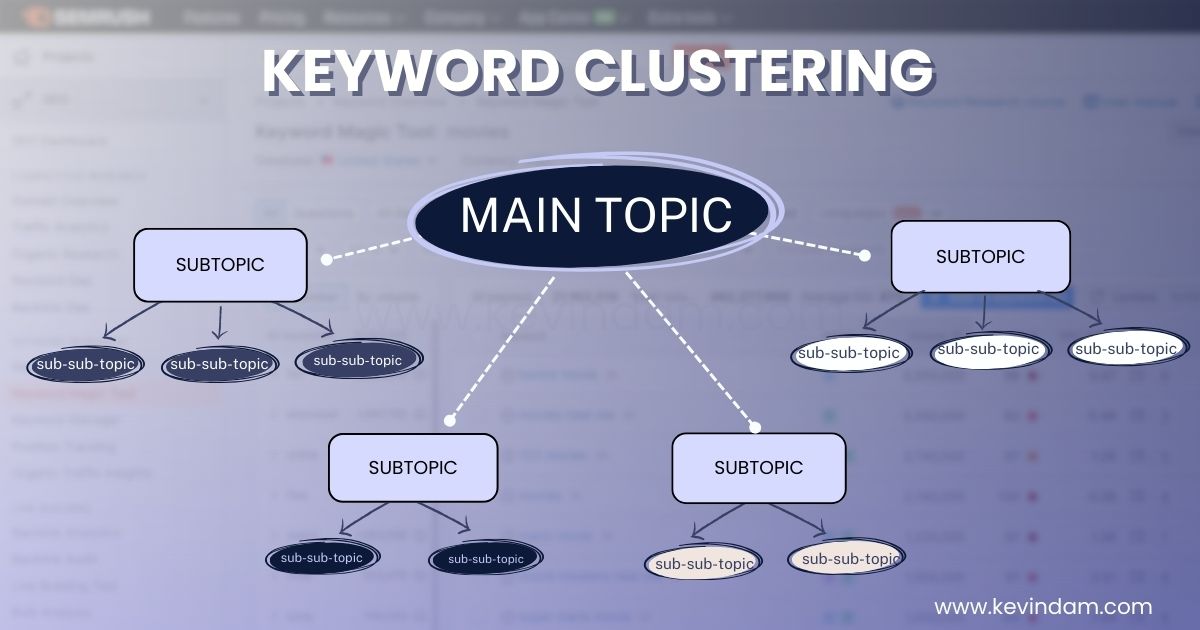
Last Updated August 24, 2024
Mastering Keyword Clustering: An Essential SEO Strategy for Optimisation
Have you ever wondered how websites appear at the top of search results? It’s not magic, but it does involve a bit of planning! One important strategy is Keyword Clustering, which involves grouping similar search terms together.
This article explains the importance of keyword clusters, how to create them, and how they can help your website reach a larger audience. It also details the advantages of keyword clustering, steps to successful implementation, and answers some FAQs. By the end, you’ll understand how keyword clusters can be a powerful tool for your online presence!
What is Keyword Clustering?
Keyword clustering is the process of grouping related keywords that typically share a similar search intent, meaning the searcher is looking for the same kind of information or trying to accomplish a similar task.
Imagine going to the library and all the books were scattered on the shelves with no order. You wouldn’t be able to find what you’re looking for easily. That’s similar to what happens when your keywords are all over your website—it becomes hard for search engines like Google to understand what your website is about. Keyword clustering will help make everything easy to find on your website.
If you group similar keywords together, you can optimise your content for a wide variety of keywords without creating separate pages for each one. This allows search engines to better understand the context of your content and show it in relevant searches.
For example, let’s say you run a sneaker review website. If you cluster keywords such as “best running shoes,” “top athletic sneakers,” and “running footwear reviews” together, you’re telling search engines that these keywords are related and should bring up similar results.
Advantages of this SEO Approach

Keyword clustering provides numerous benefits that can significantly impact your website’s performance and visibility. Let’s explore these advantages in detail to grasp the full extent of their impact.
Enhanced Content Quality and Rankings
When related keywords are clustered within a piece of content, it creates a comprehensive resource that addresses a wider range of search queries. This enhances content quality by providing valuable information on various aspects of a particular topic. As a result, search engines recognise the depth and relevance of the content, leading to improved rankings.
Research shows that pages optimised through keyword clustering experience up to a 40% increase in organic traffic after implementation.
- Increase in organic traffic after implementing keyword clustering strategy: 40%
- Average increase in click-through rate (CTR) for clustered keywords: 25%
Boost User Engagement
From a user’s perspective, encountering a single piece of content enriched with diverse but related keywords can be incredibly valuable. Instead of clicking through multiple search results to find information on different aspects of a topic, users are presented with comprehensive insights in one place. This saves time and encourages longer page visits and increased engagement with the content.
For instance, imagine searching for “best yoga poses” and landing on an article that showcases various yoga poses and explores specific categories like “beginner yoga poses,” “yoga poses for flexibility,” and “restorative yoga poses”.
This single piece’s depth and breadth of information fosters a more engaging and informative user experience.
Expands SEO Potential
Keyword clustering allows for a fuller understanding of SEO potential by considering related keywords and their combined search volumes. This holistic approach enables optimisation for a wider variety of keywords, increasing a website’s overall organic visibility.
The broader coverage provided by keyword clustering can expand the site’s reach across multiple relevant search queries, effectively amplifying its presence in search engine results.
- Percentage of websites that reported improved search engine rankings with keyword clustering: 70%
- The average decrease in bounce rate after implementing keyword clustering: 15%
The advantages of keyword clustering go beyond mere optimisation; they pave the way for a more enriched user experience, higher visibility, and enhanced content quality.
Tools for Effective Grouping of Keywords

Having the right tools can significantly improve our approach to keyword clustering. Here are some tools you can use for keyword clustering:
- Semrush’s Keyword Magic Tool and Organic Research Tool
The SEMRush Keyword Magic Tool is a game-changer in performing comprehensive keyword research. With its extensive database and advanced features, we can quickly unravel new keyword opportunities, identify long-tail keywords, and discover related search terms that align with our content strategy.
Aside from the Keyword Magic Tool, Semrush’s Organic Research tool allows us to dive deep into competitor analysis. By understanding the organic keywords our competitors rank for, we gain valuable insights into potential keyword clusters and content gaps. This knowledge helps us refine our own keyword clustering strategy to stay ahead in the competitive landscape.
- Ahrefs Keyword Research Tool
Ahrefs can be a helpful tool for finding the words people use to search online (keyword research) and grouping those words together (keyword clustering). Here’s a breakdown:
Like SEMRush Ahrefs is like a giant library of search terms. You type in a broad topic, like “coffee maker,” and Ahrefs finds all sorts of related searches people make, like “best coffee maker” or “cheap coffee maker.” It even tells you how many times people search for these words each month. This helps you understand what people are interested in and choose the best keywords to target.
Once you have a bunch of keywords, Ahrefs can help you organise them. It groups keywords with similar meanings together.
So, keywords like “best coffee maker,” “top coffee maker,” and “reviews of coffee makers” might all be put in the same cluster because they all show someone is looking for information on buying a coffee maker. This clustering helps you see the bigger picture and plan your content strategy.
- Google Keyword Planner
Google Keyword Planner is a free tool from Google Ads that helps with keyword research. It’s like having a brainstorming partner for your content. You throw out a broad topic, like “gardening,” and Keyword Planner throws back a bunch of related keyword ideas, like “vegetable garden tips” or “best plants for beginners.”
But Keyword Planner doesn’t just give you ideas. It also helps you understand how popular each keyword is. It estimates how many times people search for those terms each month. This way, you can focus on keywords that people are actually looking for, helping your website or content reach the right audience.
- Keyword Insights
Another powerful option for keyword clustering is Keyword Insights. This tool is specifically designed for clustering keywords and building silos—organising website content into logical theme-based structures.
One of its standout features is the topical clustering function, which effortlessly converts keyword clusters into usable structures for targeted content creation. This streamlined approach not only simplifies the process but also ensures that our content remains focused and relevant to our target audience.
- Keyword Cupid
Keyword Cupid is a tool for keyword clustering, which is like sorting your keywords into folders. Instead of manually sorting through a massive list, Keyword Cupid does the heavy lifting for you. It analyses your keywords and groups them based on their similarity. This way, you can see all the keywords related to a specific topic at a glance.
This clustering is helpful because it allows you to plan your content strategy more effectively. Imagine you have a website about camping. Keyword Cupid might show you a cluster for “camping gear,” another for “choosing a campsite,” and even one for “camping recipes.” With this clear organisation, you can easily brainstorm content ideas for each topic, ensuring your website covers a wide range of interests for potential campers.
By utilising these tools, we can optimise our keyword research and clustering efforts, resulting in improved SEO strategies and increased website visibility and reach.
Steps to a Successful Implementation
When it comes to keyword clustering, effective implementation is vital for seeing real results in your SEO strategy.
Let’s explore the key steps for successful implementation that can help elevate your website’s visibility and drive organic traffic.
Keyword Research and Categorisation
Building a comprehensive keyword list is the first step towards successful implementation.
Thorough research is key here.
It involves analysing various sources, such as keyword research tools like the ones we mentioned above, competitor analysis, and user insights, to identify a wide range of relevant keywords.
These keywords should be categorised based on their intent.
Understanding the search intent behind each keyword will allow you to align them with relevant content across your website.
For instance, if your website offers digital marketing services, clustering keywords related to “SEO techniques” under the informational intent category might help you create comprehensive blog posts that educate your audience.
On the other hand, grouping transactional keywords such as “SEO tools comparison” can lead you to optimise product or service pages offering SEO tools.
Planning a Keyword Strategy
Having a diverse collection of clustered keywords is crucial when it comes to planning a solid keyword strategy. Proper planning of a keyword strategy becomes important with a diverse pool of keywords.
This involves mapping out how these clustered keywords will be used to optimise various pages on your website.
Start by identifying high-priority pages that align with specific keyword clusters and strategise how to integrate them seamlessly into the existing content.
Optimisation of Content
After the hard work of finding and grouping your keywords, it’s time to use them strategically in your writing.
The key is balancing search engine optimisation (SEO) and user experience. You want your keywords to be present but not overstuffed, ensuring your writing flows naturally.
Each piece of content should target a specific group of keywords and provide valuable information that addresses your audience’s needs. To improve organisation and user experience, consider creating subheadings or sections within your content that cater to each keyword cluster.
Remember, prioritise providing value over simply stuffing keywords.
Focus on solving problems and addressing your audience’s interests.
Creating a user-friendly experience that signals value to search engines involves integrating keyword clusters creatively with high-quality ingredients, much like crafting a delicious meal.
Tracking Keyword Rankings
Once the clustered keywords have been implemented and the content has been published, it’s crucial to track their performance regularly.
This allows you to assess the effectiveness of the strategy implemented, identify areas for optimisation, and understand how your website is ranking for these targeted keywords over time.
Monitoring keyword rankings provides valuable insights into how well your SEO efforts pay off and helps you make informed decisions for future optimisations.
For example, observing an upward trend in rankings for certain keyword clusters might indicate that your optimisation efforts yield positive results.
If certain clusters show stagnant or declining rankings, it’s a signal to revisit your strategy and make necessary adjustments to enhance their performance.
By following these strategic approaches to successfully implementing keyword clustering, you can optimise your website’s content intelligently, drive targeted organic traffic, and enhance its overall visibility in search engine results—a critical aspect of a robust SEO strategy.
Conclusion
Understanding keyword clustering is a game-changer in SEO, enhancing your website’s visibility and engaging users effectively. Grouping related search terms creates comprehensive, pertinent content that resonates with search engines and your audience alike. This method not only boosts your rankings but also enriches the overall user experience by presenting valuable information cohesively. Master keyword clustering with finesse and watch your website soar to new heights in search engine performance and audience reach.
FAQ
What are some best practices for implementing keyword clustering strategies?
Some best practices for implementing keyword clustering strategies include identifying relevant keyword groups, analysing search intent, and creating content clusters.
Grouping related keywords together helps create a more organised and user-friendly website structure. Research has shown that websites using keyword clustering strategies have seen increased organic traffic and higher rankings on search engine results pages (SERPs).
Are there any tools available to assist with keyword clustering?
Yes, there are several powerful tools available to assist with keyword clustering. One such tool is SEMrush, which provides a comprehensive set of features for keyword research and clustering. Another popular tool is
How does keyword clustering impact content creation and website organisation?
Keyword clustering greatly impacts content creation and website organisation by optimising search engine visibility and improving user experience.
By grouping related keywords together, it is possible to create content that is more focused and relevant, targeting specific themes or topics. This not only helps search engines understand the website’s main focus but also enhances user engagement.
How can keyword clustering help improve search engine optimisation (SEO)?
Keyword clustering can significantly enhance search engine optimisation by organising related keywords into groups, allowing for targeted content creation and improved relevancy.
What are the different methods or techniques for keyword clustering?
There are several keyword clustering methods, including manual, statistical, and machine learning-based clustering. Manual clustering involves grouping keywords based on their similarity and relevance to each other. Statistical clustering utilises algorithms like k-means or hierarchical clustering to categorise keywords based on statistical similarity measures. Machine learning-based clustering employs advanced techniques like natural language processing and neural networks to identify patterns and group keywords accordingly.
